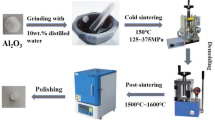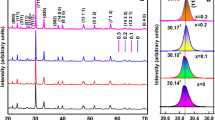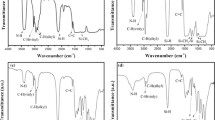Abstract
NbSi2- and TaSi2-based electroconductive ceramic composites with the addition of 40–70 vol% Al2O3 and ZrO2 particles were fabricated by high-temperature sintering (1400–1600 °C) under argon. Their phase stability, microstructural evolution, oxidation kinetics and electrical properties were studied at high temperatures. The densification of the composites was improved by increasing the oxide phase content and sintering temperature. The interaction of the starting metal disilicides with residual oxygen sources resulted in the formation of the hexagonal-structured 5–3 metal silicide (Nb5Si3 and Ta5Si3) phases. The increasing sintering temperature and volume percentage of the oxide phase reduced the pest oxidation, particularly for the silicide–alumina composites, which exhibited lower oxidation-induced mass changes than their dense monolithic metal silicides. Depending on the silicide–oxide volume percentage, their electrical conductivities ranged from 5.3 to 111.3 S/cm at 900 °C. Their phase stability, reduced oxidation rates and high electrical conductivities at high temperatures show promise for future high-temperature applications in advanced sensing.











Similar content being viewed by others
References
Chu F, Lei M, Maloy SA, Petrovic JJ, Mitchell TE (1996) Elastic properties of C40 transition metal disilicides. Acta Mater 44:3035–3048
Xu N, Xu Y, Ma J (2015) Investigations on the structural, electronic, elastic and thermodynamic properties of niobium silicide under high temperature and pressure. Mater Sci Semicond Process 30:636–644
Ravindra NM, Jin L, Ivanov D, Mehta VR, Dieng LM, Popov G, Gokce OH, Grow J, Fiory AT (2002) Electrical and compositional properties of TaSi2 films. J Electron Mater 31:1074–1079
Shon I-J, Park H-K, Kim H-C, Yoon J-K, Ko I-Y (2008) Simultaneous pulsed current activated combustion synthesis and densification of NbSi2–SiC composite. Ceram Int 34:615–619
Wan B, Xiao F, Zhang Y, Zhao Y, Wu L, Zhang J, Gou H (2016) Theoretical study of structural characteristics, mechanical properties and electronic structure of metal (TM = V, Nb and Ta) silicides. J Alloys Compd 681:412–420
Ostling M, Zaring C (1995) Thermal properties of TM silicides. In: Maex K, Rossum MV (eds) Properties of metal silicides. Inspec/IEE, London, pp 31–44
Nava F, Tu KN, Mazzega E, Michelini M, Queirolo G (1987) Electrical transport properties of transition-metal disilicides films. J Appl Phys 61:1085–1093
Pomoni K, Krontiras C, Salmi J (1990) Electrical transport properties of NbSi2 thin films. J Phys D Appl Phys 23:354–357
Chow TP, Steckl AJ (1983) Refractory metal silicides: thin-film properties and processing technology. IEEE Trans Electron Dev ED-30:1480–1497
Murarka SP, Read MH, Doherty CJ, Fraser DB (1982) Resistivities of thin film transition metal silicides. J Electrochem Soc Electrochem Sci Technol 129:293–301
Huang MT, Martin TL, Malhotra V, Mahan JE (1985) Electron transport properties of tantalum disilicide thin films. J Vac Sci Technol B 3:836–845
Binbin S, Peizhong F, Jianzhong W, Yuan G, Guangzhi W, Xiaohong W, Farid A (2014) Oxidation properties of self-propagating high temperature synthesized niobium disilicide. Corros Sci 85:311–317
Li CY, Yu ZH, Liu HZ, Lu TQ (2013) High pressure and high temperature in situ X-ray diffraction study on the structural stability of tantalum disilicide. Solid State Commun 157:1–5
Kurokawa K, Matsuoka H, Nagai T (1994) High temperature oxidation of some MSi2-type silicides. In: Yoshimura M, Maruyama T, Saito Y, Przybylski K, Stringer J (eds) Advanced materials’93. Elsevier, Amsterdam, pp 255–258
Kreider KG (1995) Thin film high temperature silicide thermocouples. U.S. Patent No. 5474619
Berztiss DA, Cerchiara RR, Gulbransen EA, Pettit FS, Meier GH (1992) Oxidation of MoSi2 and comparison with other silicide materials. Mater Sci Eng A 155:165–181
Yeh C-L, Huang Y-S (2012) Thermite-based combustion synthesis of niobium silicides/Al2O3 composites. High Temp Mater Process 16:57–69
Jo H-G, Shon I-J (2014) Simultaneous synthesis and consolidation of nanostructured WSi2–NbSi2 composite by pulsed current activated heating and its mechanical properties. J Ceram Process Res 15:371–375
Li W, Yang H, Shan A, Zhang L, Jiansheng W (2005) Microstructure and properties of directionally solidified NbSi2/Nb5Si3 composites. Mater Sci Forum 475–479:733–736
Yazdani Z, Karimzadeh F, Abbasi MH (2014) Formation mechanism of NbSi2–Al2O3 nanocomposite subject to mechanical alloying. Adv Powder Technol 25:1357–1361
Carrillo-Heian EM, Unuvar C, Gibeling JC, Paulino GH, Munir ZA (2001) Simultaneous synthesis and densification of niobium silicide/niobium composites. Scr Mater 45:405–412
Rigney JD, Lewandowski JJ (1996) Loading rate and test temperature effects on fracture of in situ niobium silicide–niobium composites. Metall Mater Trans A 27A:3292–3306
Jo H-G, Shon I-J (2014) Pulsed current activated synthesis and consolidation of nanostructured MoSi2–NbSi2 composite and its mechanical properties. Mater Trans 55:391–394
Silvestroni L, Sciti D (2011) Densification of ZrB2–TaSi2 and HfB2–TaSi2 ultra-high-temperature ceramic composites. J Am Ceram Soc 94:1920–1930
Talmy IG, Zaykoski JA, Opeka MM (2008) High-temperature chemistry and oxidation of ZrB2 ceramics containing SiC, Si3N4, Ta5Si3, and TaSi2. J Am Ceram Soc 91:2250–2257
Wang S, Xu C, Ding Y, Zhang X (2013) Thermal shock behavior of ZrB2–SiC composite ceramics with added TaSi2. Int J Refract Metals Hard Mater 41:507–516
Sciti D, Silvestroni L, Guicciardi S, Fabbriche DD, Bellosi A (2009) Processing, mechanical properties and oxidation behavior of TaC and HfC composites containing 15 vol% TaSi2 or MoSi2. J Mater Res 24:2056–2065
Kobel S, Pluschke J, Vogt U, Graule TJ (2004) MoSi2–Al2O3 electroconductive ceramic composites. Ceram Int 30:2105–2110
Yamamoto H, Sendai S (1989) Study on high temperature thermistor made of MoSi2-granular Al2O3 composite. J Ceram Soc Jpn 97:783–786
Yakaboylu GA, Pillai RC, Sabolsky K, Sabolsky EM (2017) Stability and electrical properties of MoSi2- and WSi2-oxide electroconductive composites. J Am Ceram Soc 100:4461–4475
Yakaboylu GA, Pillai RC, Sabolsky K, Sabolsky EM (2018) MoSi2- and WSi2-based embedded ceramic composite thermocouples for high-temperature and harsh-environment sensing. Sens Actuators A Phys 272:139–152
Schneider CA, Rasband WS, Eliceiri KW (2012) NIH image to ImageJ: 25 years of image analysis. Nat Methods 9:671–675
Lutterotti L, Matthies S, Wenk H-R (1999) MAUD: a friendly Java program for material analysis using diffraction. IUCr Newsl CPD 21:14–15
ASTM B193-16 Standard test method for resistivity of electrical conductor materials. ASTM International, West Conshohocken
Razavi-Tousi SS, Yazdani-Rad R, Manafi SA (2011) Effect of volume fraction and particle size of alumina reinforcement on compaction and densification behavior of Al–Al2O3 nanocomposites. Mater Sci Eng A 528:1105–1110
Rahaman MN (2003) Ceramic processing and sintering. Marcel Dekker, New York
Guo S-Q (2009) Densification of ZrB2-based composites and their mechanical and physical properties: a review. J Eur Ceram Soc 29:995–1011
Yan Z, Martin CL, Guillon O, Bouvard D (2013) Effect of size and homogeneity of rigid inclusions on the sintering of composites. Scr Mater 69:327–330
Bauer JT, Scholz A, Berger C, Weiler L, Achtermann M (2008) Influence of metastable tetragonal ZrO2-reinforcements on the properties of MoSi2-composites. Int J Mater Res 99:352–358
Skandan G, Hahn H, Roddy M, Cannon WR (1994) Ultrafine-grained dense monoclinic and tetragonal zirconia. J Am Ceram Soc 77:1706–1710
Okada S, Okita K, Hamano K, Lundstrom T (2011) Growth conditions of Nb3Si, α-Nb5Si3 and NbSi2 single crystals from high-temperature metal solutions and properties of the crystals. High Temp Mater Process 13:311–318
Talmy IG, Zaykoski JA, Opeka MM, Smith AH (2006) Properties of ceramics in the system ZrB2–Ta5Si3. J Mater Res 21:2593–2599
Schlesinger ME (1994) The Si–Ta (silicon–tantalum) system. J Phase Equilib 15:90–95
Chow TP, Lu WJ, Steckl AJ, Baliga BJ (1986) Thin film properties of sputtered niobium silicide on SiO2, Si3N4 and N+ poly-Si. J Electrochem Soc 133:175–178
Pinnow CU, Bicker M, Geyer U, Schneider S, Goerigk G (2001) Decomposition and nanocrystallization in reactively sputtered amorphous Ta–Si–N thin films. J Appl Phys 90:1986–1991
Choi Y-J, Yoon J-K, Kim G-H, Yoon W-Y, Doh J-M, Hong K-T (2017) High temperature isothermal oxidation behavior of NbSi2 coating at 1000–1450 °C. Corros Sci 129:102–114
Tougas IM, Amani M, Gregory OJ (2013) Metallic and ceramic thin film thermocouples for gas turbine engines. Sensors 13:15324–15347
Grobnic D, Smelser CW, Mihailov SJ, Walker RB (2006) Long-term thermal stability tests at 1000 °C of silica fibre Bragg gratings made with ultrafast laser radiation. Meas Sci Technol 17:1009–1013
Bennethum WH, Sherwood LT (1988) Sensors for ceramic components in advanced propulsion systems. NASA Contractor Report 180900
Yeh CL, Huang YS (2011) Thermite reduction of Ta2O5/SiO2 powder mixtures for combustion synthesis of Ta-based silicides. J Alloys Compd 509:6302–6306
Lux F (1993) Models proposed to explain the electrical conductivity of mixtures made of conductive and insulating materials. J Mater Sci 28:285–301. https://doi.org/10.1007/BF00357799
Petrovic JJ, Pena MI, Reimanis IE, Sandlin MS, Conzone SD, Kung HH, Butt DP (1997) Mechanical behavior of MoSi2 reinforced-Si3N4 matrix composites. J Am Ceram Soc 80:3070–3076
Lemus-Ruiz J, Leon-Patino CA, Aguilar-Reyes EA (2006) Interface behavior during the self-joining of Si3N4 using a Nb-foil interlayer. Scr Mater 54:1339–1343
Zhang F, Zhang LT, Shan AD, Wu JS (2005) In situ observations of the pest oxidation process of NbSi2 at 1023 K. Scr Mater 53:653–656
Mitra R (2006) Mechanical behaviour and oxidation resistance of structural silicides. Int Mater Rev 51:13–64
Zhang F, Zhang LT, Shan AD, Wu JS (2006) Microstructural effect on oxidation kinetics of NbSi2 at 1023 K. J Alloys Compd 422:308–312
Niu Y, Huang L, Zhai C, Zeng Y, Zheng X, Ding C (2015) Microstructure and thermal stability of TaSi2 coating fabricated by vacuum plasma spray. Surf Coat Technol 279:1–8
Voglewede B, Rangel VR, Varma SK (2012) The effects of uncommon silicides on the oxidation behavior of alloys from the Nb–Cr–Si system. Corros Sci 61:123–133
Kurokawa K, Yamauchi A, Matsushita S (2005) Improvement of oxidation resistance of NbSi2 by addition of boron. Mater Sci Forum 502:243–248
Wang W, Yuan B, Zhou C (2014) Formation and oxidation resistance of germanium modified silicide coating on Nb based in situ composites. Corros Sci 80:164–168
Stergiou A, Tsakiropoulos P (1997) The intermediate and high-temperature oxidation behaviour of (Mo, X)Si2 (X = W, Ta) intermetallic alloys. Intermetallics 5:117–126
Chan KS (2004) Cyclic oxidation response of multiphase niobium-based alloys. Metall Mater Trans A 35A:589–597
Ito Y, Sato M, Wakisaka K, Yoshikado S (2009) Improvement of heating characteristics of molybdenum silicide thin film electric heaters. Electr Eng Jpn 168:452–458
Gottlieb U, Nava F, Affronte M, Laborde O, Madar R (1995) Electrical transport in metallic TM silicides. In: Maex K, Rossum MV (eds) Properties of metal silicides. Inspec/IEE, London, pp 189–204
Acknowledgements
This research was funded by the U.S. Department of Energy, National Energy Technology Laboratory under contract DE-FE0012383. The authors greatly appreciate Dr. Maria Reidpath from the U.S. Department of Energy for her insight and valuable guidance. We also acknowledge the use of the WVU Shared Research Facilities.
Author information
Authors and Affiliations
Corresponding author
Ethics declarations
Conflict of interest
No conflicts of interest.
Electronic supplementary material
Below is the link to the electronic supplementary material.
Rights and permissions
About this article
Cite this article
Yakaboylu, G.A., Sabolsky, K. & Sabolsky, E.M. Phase stability, microstructure and high-temperature properties of NbSi2- and TaSi2-oxide conducting ceramic composites. J Mater Sci 53, 9958–9977 (2018). https://doi.org/10.1007/s10853-018-2297-1
Received:
Accepted:
Published:
Issue Date:
DOI: https://doi.org/10.1007/s10853-018-2297-1




